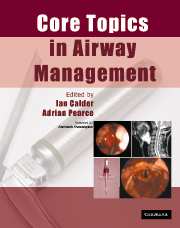Book contents
- Frontmatter
- Contents
- List of contributors
- Preface
- Acknowledgements
- List of abbreviations
- 1 Anatomy
- 2 Physiology of apnoea and hypoxia
- 3 Physics and physiology
- 4 Cleaning and disinfection of airway equipment
- 5 General principles
- 6 Maintenance of the airway during anaesthesia: supra-glottic devices
- 7 Tracheal tubes
- 8 Tracheal intubation of the adult patient
- 9 Confirmation of tracheal intubation
- 10 Extubation
- 11 Light-guided intubation: the trachlight
- 12 Fibreoptic intubation
- 13 Retrograde intubation
- 14 Endobronchial and double-lumen tubes, bronchial blockers
- 15 ‘Difficult airways’: causation and prediction
- 16 The paediatric airway
- 17 Obstructive sleep apnoea and anaesthesia
- 18 The airway in cervical trauma
- 19 The airway in cervical spine disease and surgery
- 20 The aspiration problem
- 21 The lost airway
- 22 Trauma to the airway
- 23 Airway mortality associated with anaesthesia and medico-legal aspects
- 24 ENT and maxillofacial surgery
- 25 Airway management in the ICU
- 26 The airway in obstetrics
- Index
20 - The aspiration problem
Published online by Cambridge University Press: 15 December 2009
- Frontmatter
- Contents
- List of contributors
- Preface
- Acknowledgements
- List of abbreviations
- 1 Anatomy
- 2 Physiology of apnoea and hypoxia
- 3 Physics and physiology
- 4 Cleaning and disinfection of airway equipment
- 5 General principles
- 6 Maintenance of the airway during anaesthesia: supra-glottic devices
- 7 Tracheal tubes
- 8 Tracheal intubation of the adult patient
- 9 Confirmation of tracheal intubation
- 10 Extubation
- 11 Light-guided intubation: the trachlight
- 12 Fibreoptic intubation
- 13 Retrograde intubation
- 14 Endobronchial and double-lumen tubes, bronchial blockers
- 15 ‘Difficult airways’: causation and prediction
- 16 The paediatric airway
- 17 Obstructive sleep apnoea and anaesthesia
- 18 The airway in cervical trauma
- 19 The airway in cervical spine disease and surgery
- 20 The aspiration problem
- 21 The lost airway
- 22 Trauma to the airway
- 23 Airway mortality associated with anaesthesia and medico-legal aspects
- 24 ENT and maxillofacial surgery
- 25 Airway management in the ICU
- 26 The airway in obstetrics
- Index
Summary
Effects of aspiration
Aspiration is the process by which material is carried from the pharynx to the lower respiratory tract. The clinical outcome depends on the volume and nature of the aspirate, its distribution and the host defence mechanisms. The consequences can vary from relatively benign to fulminant acute respiratory failure and death. Aspiration of solids or semisolids may cause airway obstruction. Aspiration of acidic gastric contents can cause a pneumonitis with bronchospasm and pulmonary oedema (Mendelson's Syndrome). A ventilation–perfusion mismatch will occur. In some patients worsening hypoxaemia may develop and lead to the adult respiratory distress syndrome (ARDS). Of those patients that aspirate 64% have no respiratory sequelae, 20% require ventilation on an intensive therapy unit (ITU) for more than 6 h and 5% die. If no symptoms or signs are present 2 h after an episode of aspiration, respiratory sequelae are unlikely.
Diagnosis of aspiration
Symptoms: Most patients are unconscious and asymptomatic, but conscious patients will complain of breathing difficulty.
Signs: Dyspnoea and tachypnoea develop, often with a cough productive of pink frothy sputum. Tachycardia and hypotension are observed. The principal sign of aspiration is hypoxaemia. Even a few millilitres of saline instilled into the trachea will cause a temporary drop in oxygen saturation. Localized or diffuse wheeze and crackles may be heard on auscultation of the chest.
Investigations: Diffuse alveolar infiltrates usually in the lower lobes are apparent on the chest radiograph.
The risk of pulmonary aspiration
Aspiration occurs in 1 in 4000 anaesthetics for elective surgery and 1 in 900 for emergency surgery. If a tracheal tube is used then aspiration is just as likely after extubation as during induction.
- Type
- Chapter
- Information
- Core Topics in Airway Management , pp. 151 - 158Publisher: Cambridge University PressPrint publication year: 2005



